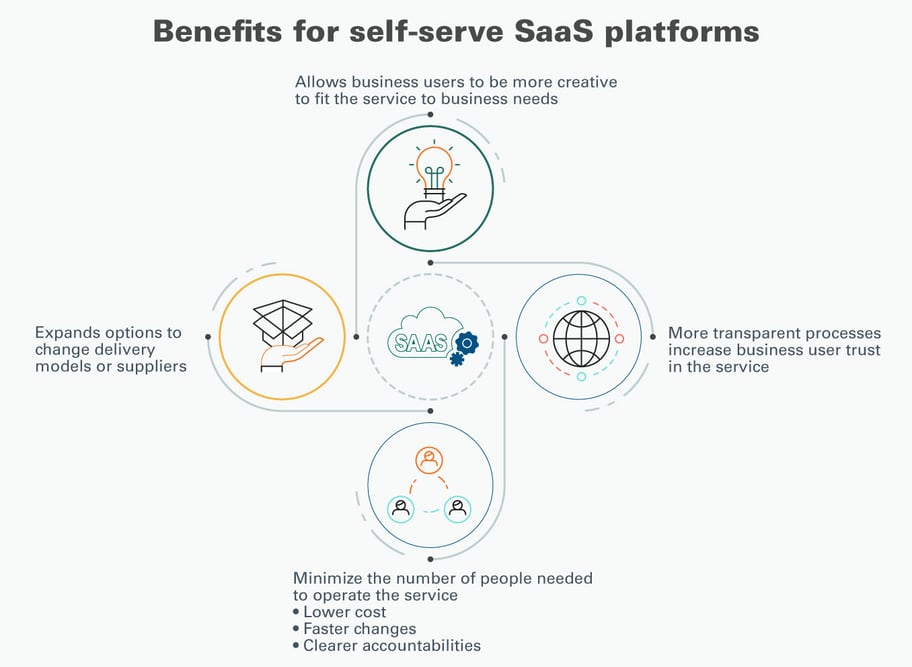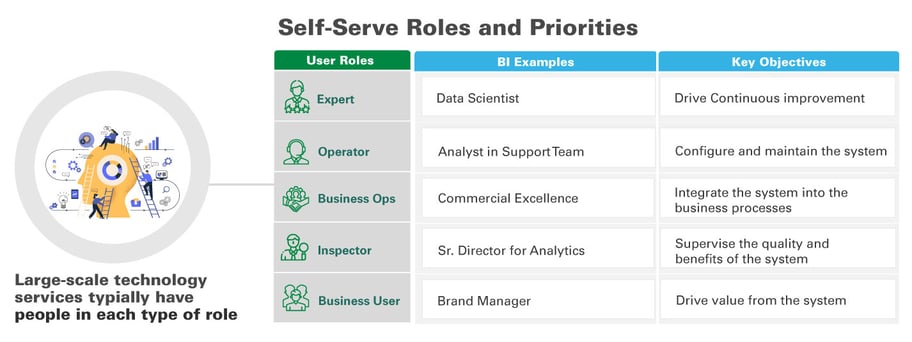Life science organizations are moving fast in adopting cloud-based technology solutions to meet their data and analytics needs. While there’s no contention that data is becoming increasingly vital for the success of pharma and life science commercial operations, companies are still struggling to choose between point solutions and custom build implementations. Buying off-the-shelf products can guarantee a faster go-to-market scenario, while custom-built projects mean more control and customizability. The flip side of custom-built solutions is the longer implementation timelines due to multiple stakeholder requirements. Business users and data scientists prefer glass box solutions to access the data, view the lineage, and slice and dice the information to create their reports. While they consume pre-built reports, data scientists and data stewards wish to access the raw data in sandbox environments to perform their analysis and create their analytical models. Hence the onus is on technology companies to build solutions that offer a shorter time to market without compromising on control and customizability.
Self-serve analytics is an alternative approach to traditional business intelligence, enabling non-IT professionals to be more independent in accessing and working with data even if they do not have a background in statistical analysis, business intelligence, or data mining. This approach uses agile methods and modern technology to automate data access, preparation, consumption, and analysis. Empowering business users with more timely, meaningful, and flexible analytical capabilities is essential for an effective and insight-driven life science organization. Organizations with self-service capabilities do not need to invest in large IT teams to help business users experience first-hand access to insights. Slow turnaround times and pre-built templates no longer need to be barriers to analytics generation.
To enable an environment where business users thrive , organizations need to invest in modern self-service data platforms that support the following:
- Data ingestion across multiple sources, both structured and unstructured
Business users need to access the right data sources, both in raw and integrated form , to perform analysis. They should be allowed to query and generate reports on demand without IT intervention. Minimizing the need for IT support with self-service data discovery allows users to find the right data sets and explore data lineage easily.
- Data lake environments to store, prepare, and provision large volumes of data to meet analytical requirements
Business users and data scientists need sandbox environments where they can perform their analysis and get a view of all the data available. The ability to create analytical models and reports in their sandbox ensures freedom of analysis and better decision-making.
- Serving data to the business in an intuitive consumable format through a flexible and easy-to-use interface
User interface (UI) design is an important factor in encouraging business users to explore the platform and perform their own analysis. The platform should be self-explanatory and business users must require minimal training to use it.
- Modern data platforms with glass box solutions
Black box solutions offer little flexibility, with complex algorithms and no view into its processes. Self-service platforms need to be transparent and designed on simpler algorithms for business users to understand and customize based on their requirements. For example, suppose a user wants to change a particular business rule, with the help of an intuitive UI, they can simply modify the rule in the business rule engine themselves rather than waiting on an IT team member to do so.
- Data fabric architectures for more federated operation models
Data platforms built on data fabric concepts simplify data access across the organization to facilitate self-service data consumption. A data fabric automates data discovery, governance, and consumption, enabling enterprises to use data to maximize their value chain.
SELF-SERVE ANALYTICS ARE BETTER THAN TRADITIONAL ANALYTICS... WHY IS THAT?
A self-service data platform allows emerging pharma and life sciences companies to accelerate past data engineering intricacies and focus on ad hoc analytics to discern how their data can help them meet objectives for clinical operations, medical affairs, and commercial teams.

While there are several benefits to implementing self-service platforms, organizations must deal with certain risks and challenges.
- Mishandling the change management process to help users adopt and embed
- Struggle to enforce standards
- Risk a proliferation of reports and metrics
- Misuse of features or data attributes that others later misinterpret
- Poorly curated data can be more challenging for business users to work around versus well-trained specialists
- Business users’ inability to understand system limitations/peculiarities
While implementing a self-service data and analytics platform, it is vital to roll out a service design and change management process to consider the needs of different user roles.

Self-service analytics represents a fundamental shift in how IT and business users collaborate to get insights from their information sources. Historical approaches for supporting end users included creating spreadsheet-driven models, shadow systems, and custom SQL queries. These fragmented approaches often fall short in meeting stakeholder expectations. With the introduction of modern technologies, organizations can now implement effective self-service analytics programs, drastically reducing development time, cost, and data quality issues by considering four important guidelines:
- Align stakeholders to a single vision focused on business impact
A compelling vision can provide stakeholders with a clear understanding of how self-service analytics can help them meet their business objectives. This vision should answer questions such as what business functions and systems are impacted, which stakeholders are involved, what capabilities are needed, and what benefits will be achieved. Alignment of stakeholders like senior executives, analysts, and IT on how empowering functional business users with analytics capabilities will transform the organization’s ability to meet the needs of its customers.
- Restructure architecture to eliminate barriers to self-service analytics
Self-service analytics can transform the relationship between business users and the IT team by automating data preparation tasks and shifting the analysts’ focus to understanding, discovering, and delivering valuable insights. IT teams can focus on more technically complex activities such as infrastructure management, technology optimization, and data provisioning. Restructuring processes to deliver seamless service is an important consideration that typically requires teamwork between business and IT teams.
- Engage users with meaningful analytics discovery
To promote the adoption of self-service platforms, there should be a focus on customer experience. Change management, training, and continuous improvement are essential components for adoption and collaboration. Business users must be trained on the new platform to perform analytic functions with minimal IT support. IT teams must learn new skills and processes to support the new technology. Platforms must be designed to be scalable to incorporate future analytical and technical requirements.
- Provide an enterprise-level governance strategy for data-driven decision-making
Self-service analytics platforms give business users the ability to enhance their decision-making and generate on-demand insights. To promote consistency, self-service analytics programs must include controls, standards, and decision rights that are coordinated with enterprise data governance. When aligned with an enterprise’s priorities and comprehensive data governance program, the organization can gain a repeatable, scalable framework that increases the agility and effectiveness of future analytics projects.
Axtria can help organizations use self-service analytics to increase the effectiveness of data platforms
Axtria DataMAx™ is the next-generation global cloud-based commercial life sciences data management product that enables accelerated actionable business insights from trusted data. Axtria DataMAx™ facilitates rapid integration of all major structured and unstructured life sciences data sources securely, accurately, and with industry compliance. Data quality and business management rules are applied to make sure the data being processed is conditioned for its intended use and can be trusted. Users can provision data mart creation for downstream consumption and reporting by analytics systems, models, or individual data stewards. Through its self-service capabilities, Axtria DataMAxTM clients have seen a 20% increase in the productivity of their data scientists and stewards. On an average, 7 out of 10 new data sets are onboarded on Axtria DataMAx™ without IT dependencies for data discovery.
Axtria CustomerIQ™ is the most advanced omnichannel-driven customer engagement solution for the life sciences. It enables personalized interactions, at scale, across life Sciences customers to optimize commercial activity. Axtria CustomerIQ™ offers superior next best action (NBA) decision and orchestration engines, which are driven by a self-learning AI/ML engine and clean, trusted, diverse data sets that provide every facet of information needed to ensure effective engagement recommendations, complemented by a holistic understanding of the customer’s journey. Axtria CustomerIQTM promotes low-code self-service operations with the flexibility to configure solutions to business needs.
CONCLUSION
In 2022, the self-service analytics market is predicted to grow to/reach $10 billion and comprise 80%. Self-service analytics helps insight-driven organizations transcend from traditional reporting and business intelligence tools to automated data preparation and advanced analytics capabilities. Harnessing the true potential of data can be done only if this data is converted to actionable insights. Organizations embarking on this journey have discovered that by focusing on specific use cases, engaging business users from the outset, and leveraging a modern analytics architecture, they establish a platform for self-service analytics that can be scaled across the enterprise. Axtria’s product suite can help life science companies traverse through the data to insights to action journey in a seamless manner backed by a robust technology framework.
References
- Global Self-Service Analytics Market 2021
https://www.marketresearchfuture.com/reports/self-service-analytics-market-1984
.jpg?width=190&name=A1390_Megha%20Kapadia%20(1).jpg)



